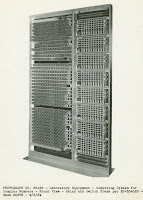The Scrap-Book premiered in 1837 as a literary journal. Though one of the first, it would not be the last of a long list of literary and lifestyle publications Dartmouth students have published. The 1915 Third Rail, was "A Magazine of Adventures," and covered a wide range of topics considered to be of interest to the adventurers of Dartmouth College. Pace, a Dartmouth Lifestyle Magazine, from 1947, was packed with articles that could be lifted almost exactly from a modern publication. Along with the struggle of balancing weekend fun and school life and a discussion of the positives and negatives of fraternities at Dartmouth, the article "Advice to Freshmen" could be pasted into a guide for the class of 2017 with few noticeable changes.
 Publications
that feel the most dated upon rereading tend to be those covering social and
political issues. The Tomahawk began
in 1928 to fight "bigotry, muddle-headedness, and obscurantism" long before many
of the battles later publications would fight were even thought of as problems.
The irony of appropriating the term "tomahawk" to fight bigotry at a time when
Native Americans were primarily represented at Dartmouth through caricatures of the "Indian" mascot seems to have been lost on the editors. In
Your Face! ran from 1990-1992 and was dedicated to making Dartmouth's lesbian and
gay community more visible. Spare Rib
covered women's issues at Dartmouth in the early 1990's, running at the same
time as the more radical Inner Bitch.
Uncommon Threads, running from
1996-2000, served as an "anti-racist, anti-homophobic, anti-sexist and
anti-classist" publication grappling with identity at Dartmouth.
Publications
that feel the most dated upon rereading tend to be those covering social and
political issues. The Tomahawk began
in 1928 to fight "bigotry, muddle-headedness, and obscurantism" long before many
of the battles later publications would fight were even thought of as problems.
The irony of appropriating the term "tomahawk" to fight bigotry at a time when
Native Americans were primarily represented at Dartmouth through caricatures of the "Indian" mascot seems to have been lost on the editors. In
Your Face! ran from 1990-1992 and was dedicated to making Dartmouth's lesbian and
gay community more visible. Spare Rib
covered women's issues at Dartmouth in the early 1990's, running at the same
time as the more radical Inner Bitch.
Uncommon Threads, running from
1996-2000, served as an "anti-racist, anti-homophobic, anti-sexist and
anti-classist" publication grappling with identity at Dartmouth.Finally, there are a few publications that just don't make sense to the modern reader. Old Grimes seems to be a mix of satire and inside jokes from 1848. The modern reader will be left searching for the meaning of lines such as, "why is Hoyle BROOKE unnatural? Because he won't run down HILL!" Was it acknowledged as a point of humor that The Dart and The Mouth existed as two separate publications in 1947? Why was Bug chosen as the name of a 1992 journal of progressive analysis and not a magazine studying insects? Come by Rauner and attempt to puzzle out the answers to all these questions by looking through Dartmouth's periodicals, both the well-known and the widely forgotten.
Posted for Kate Taylor '13.






